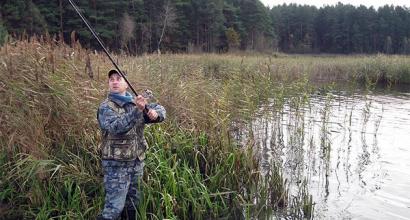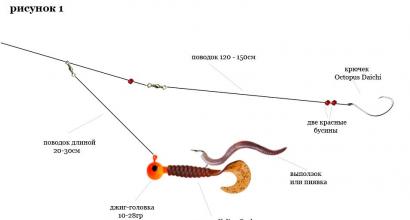Catching carp on a float rod. Float biting calendar
All leading sport anglers started their careers with simple but exciting types of fishing. Catching carp with a float rod is a classic of the genre. It combines excitement, unpredictability and bewitching beauty. Despite the prevalence of crucian carp, catching even a small fish can be quite problematic. Some of the secrets of this method of fishing will be revealed by experienced anglers.
Crucian belongs to heat-loving fish, although this fish has separate flashes of biting even in winter. But purposefully fishing is carried out in the open water season. Depending on the season, crucian carp can occupy different parts of the reservoir.
- After hibernation, crucian carp enter shallow water areas in which the water has warmed up a little. In such a period, it is better to catch near the shore near the wintering pits. As the water warms up, hunt for crucian carp should be on the border of algae and clean water, at depth differences, in snags.
- In hot weather, crucian carp can hide in the shade of trees and bushes, as well as under water lilies. The fish comes to the confluence of rivers and streams, where it accumulates in cool water.
- In autumn, the most promising places for fishing will be channel edges, entrances and exits from the pits.
baits for float rods
Many anglers consider crucian carp a capricious fish. Often you have to watch how a neighbor pulls crucians out of the water one by one. And other anglers occasionally have cautious bites. The reason for this phenomenon is often the bait. The crucian should have a rich set of baits and baits with them, only in this case you can count on a good catch. The table will help you choose catchy baits for a float fishing rod.
Bait for carp
When catching carp on a float, you can not do without bait. It allows you to collect a lot of fish at the point of fishing. For classic fishing on float tackle, various types of bait are used.
- Store formulations contain all the necessary components to interest crucian carp in different water bodies. It is important to consider that crucian prefer feeding near the bottom.. Therefore, bait should not disintegrate in the upper layers of the water. It is advisable to make dense balls with the addition of sand or clay.
- Homemade cereals work well in warm weather, from late spring to early fall. For cooking, anglers use millet, pearl barley, oatmeal, peas, etc.
Types of float gear
Fishing crucian on float tackle today is multifaceted. Along with the traditional methods, new ones have also appeared. The most popular with anglers are fly rod, match and plug.
| Types of float rods | max | match | plug |
| The fly rod is considered archaic by many anglers. But in some cases, the use of the swing is not only justified, but also more profitable. Fly tackle allows you to quickly catch active fish, as well as successfully fish from a boat or in a limited area of \u200b\u200bthe reservoir. | The match rod is designed for long distance fishing. Thanks to the reel and heavy equipment, it is possible to catch crucian carp at a distance of up to 40-50 m from the shore. And when playing large prey, the match has an advantage due to the friction brake of the reel. | Recently, some anglers have successfully caught crucian carp using a plug. Tackle allows you to send the bait to the baited place with high accuracy. So far, the high cost of the rod prevents the mass distribution of the plug. |
Float fishing for carp in spring
In the spring, crucian fishing is carried out close to the coastline, so a fly rod will be the best tackle. After the winter, the fish is not active, so it is advisable to feed the fishing point in small portions. It is better to underfeed crucian than to lose the opportunity to see the bite of a well-fed fish .
Spring fishing is carried out with a set of animal lures. The best baits for the float will be worms, bloodworms, caddis flies, maggots. Accordingly, the same animal components should be present in the bait mixture.
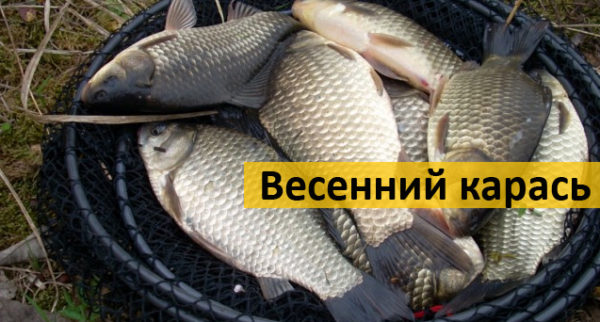
Catching carp with a float rod in summer
With the onset of summer, crucian carp rushes to search for young algae. Here the fish finds both food and shelter from predators. Anglers have to make long casts to the border of clear water and grassy thickets. A plug or match is capable of providing the required casting distance. If you have a boat, fishing in the windows of water lilies can become interesting and catchy. In such places, a fly rod is also suitable.
In summer, picking up a catchy bait becomes even more difficult. Along with baits, carp should be offered all kinds of vegetable baits. Best of all, the fish reacts to boiled barley, dough, semolina, bread, oatmeal.
Advice. Anise drops, honey, fruit flavors will help to make the nozzle more attractive.
Catching carp on a float rod in autumn
With the advent of autumn, some anglers switch to other types of fishing. However, with a competent approach during this period, you can catch trophy crucian carp. It is very important to choose a place where the fish are concentrated. This usually occurs on the riverbed edges or dumps. Often only a match rod can cast to a given point.
In the fall, do not plentifully lure the place of fishing. It is better to throw small portions of bait, watching the reaction of the fish. To guess with the bait, the angler must have both plant baits and baits with him.
Calendar biting crucian on a float
Fishing for carp with a float rod has seasonal restrictions. Therefore, before you go fishing with a float, it is better to look at the biting calendar.
| Carp biting calendar | January | February | March | April | May | June | July | August | September | October | november | December |
| - | - | - | + | ++ | +++ | +++ | +++ | ++ | + | - | - |
Fly rod equipment
The modern fly rod is seriously different from the old "oak" gear. For a complete set, it is necessary to choose high-quality accessories that will allow you to extract even a record crucian from the reservoir.
- The rod is selected without guides and reel seat 4-6 m long.
- A monofilament fishing line with a diameter of 0.20-0.25 mm is tied to the tip of the fishing rod.
- For a leash, a nylon or fluorocarbon thread with a thickness of 0.16-0.20 mm is suitable.
- The size of the hook depends on the size of the possible prey and the bait used. Hook No. 10-12 is considered universal.
- For the swing, a float-antenna is most often chosen. Its load capacity should be 1-3 g.
- For loading, one sliding sinker (80-90% of the carrying capacity of the float) and several pellets can be used.
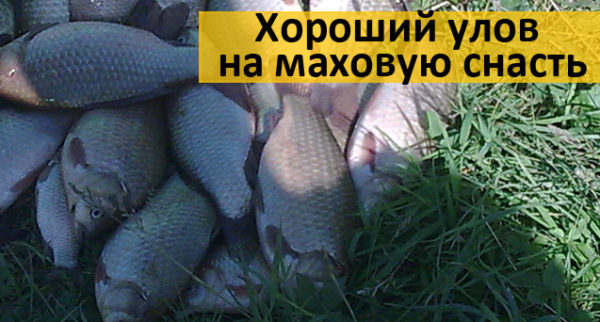
Match tackle set
The most common tackle for floaters who hunt crucian carp is a match rod. For casting equipment over long distances, it is necessary to responsibly approach the configuration of the fishing rod.
- A “stick” with throughput rings and a reel seat is suitable for the role of a rod. The length of the fishing rod is limited to the range of 3.6-4.5 m.
- The best option would be to install a spinning reel with a 2000-2500 spool on the rod.
- As the main line, you can use monofilament 0.18-0.20 mm. Important: the fishing line must be wound up to the edges of the spool.
- The leash is made of nylon thread with a diameter of 0.14-0.16 mm and hook No. 8-10.
- The most common bite indicator for a match is a sliding bobber called a waggler. It has a relatively large mass, which helps to cast the equipment far. The float antenna should be bright so that the angler can see the moment of bite even with a lot of rough water.
- The wagler is loaded with a sliding sinker-olive and several lead pellets.
Plug assembly
Anglers with a plug can increasingly be found on our reservoirs. To catch crucian carp with this modern tackle, you need to correctly assemble a fishing rod.
- The length of the plug rod should be within 6-10 m.
- The equipment consists of a monofilament fishing line with a diameter of 0.12-0.14 mm.
- A float with a carrying capacity of 0.7-1.0 g is mounted on the fishing line.
- The load is distributed quite simply. The main sinker is attached below the float, and the shed is lowered closer to the hook.
- The hook should be selected under the bait. So when fishing for a worm, hook No. 10-12 is suitable, and for bloodworms or maggots, No. 16-18 is required.
If granular compound feed is used as bait, then a rubber ring is additionally needed. It can be easily cut out of a medical glove. A granule is mounted inside the ringlet, and the hook is hooked under the elastic band.
When using the plug, the angler needs to stock up on special stands with rollers, along which the removable knees of the rod will slide.
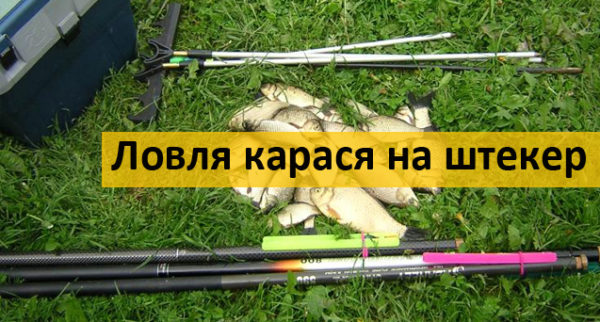
In order for the tackle to be as sensitive as possible when biting a cautious carp, you need to spend a little time loading the float. The weight of the sinkers is considered to be correctly selected when only the working part of the float is visible from the water. Usually it is highlighted in red or orange.
Achieving the perfect load is not so difficult. This is done in two steps.
- First, the main sinker clings to the fishing line. Its weight should be such that the entire body of the float is submerged in water.
- With the help of light sheds, it should be ensured that only the working part remains above the surface of the water. Usually this is 1/2 or 1/3 of the antenna.
Collapsible keels can be found in wagler-type floats. They are equipped with a set of washers, thanks to which you can reduce or increase the weight of the float. At the same time, having removed the washer, it is necessary to add a sinker of a similar mass to the fishing line. Such manipulations are designed to speed up the immersion of the equipment.
Fishing for carp with a float fishing rod attracts fishing enthusiasts with its entertainment and excitement. It is difficult to remain indifferent when the float antenna, having swung several times, smoothly goes to the side or under the water. Not every type of fishing can deliver such pleasure from the process.
In contact with

